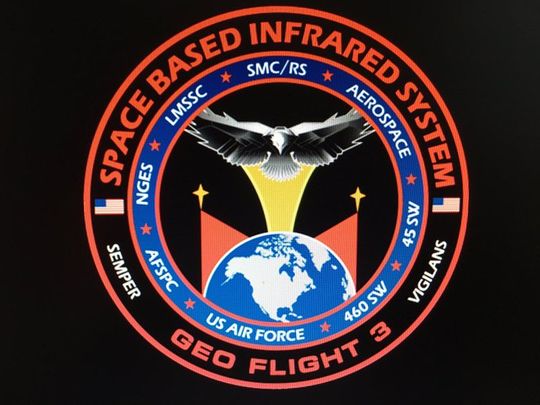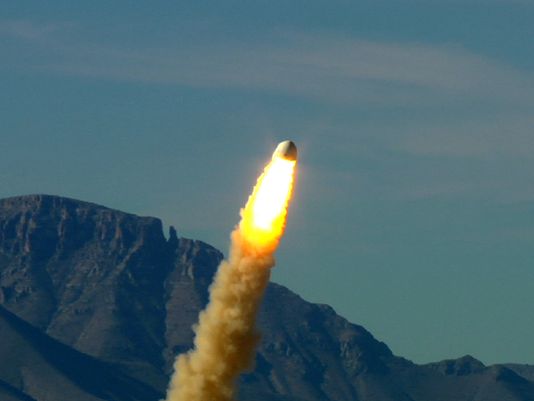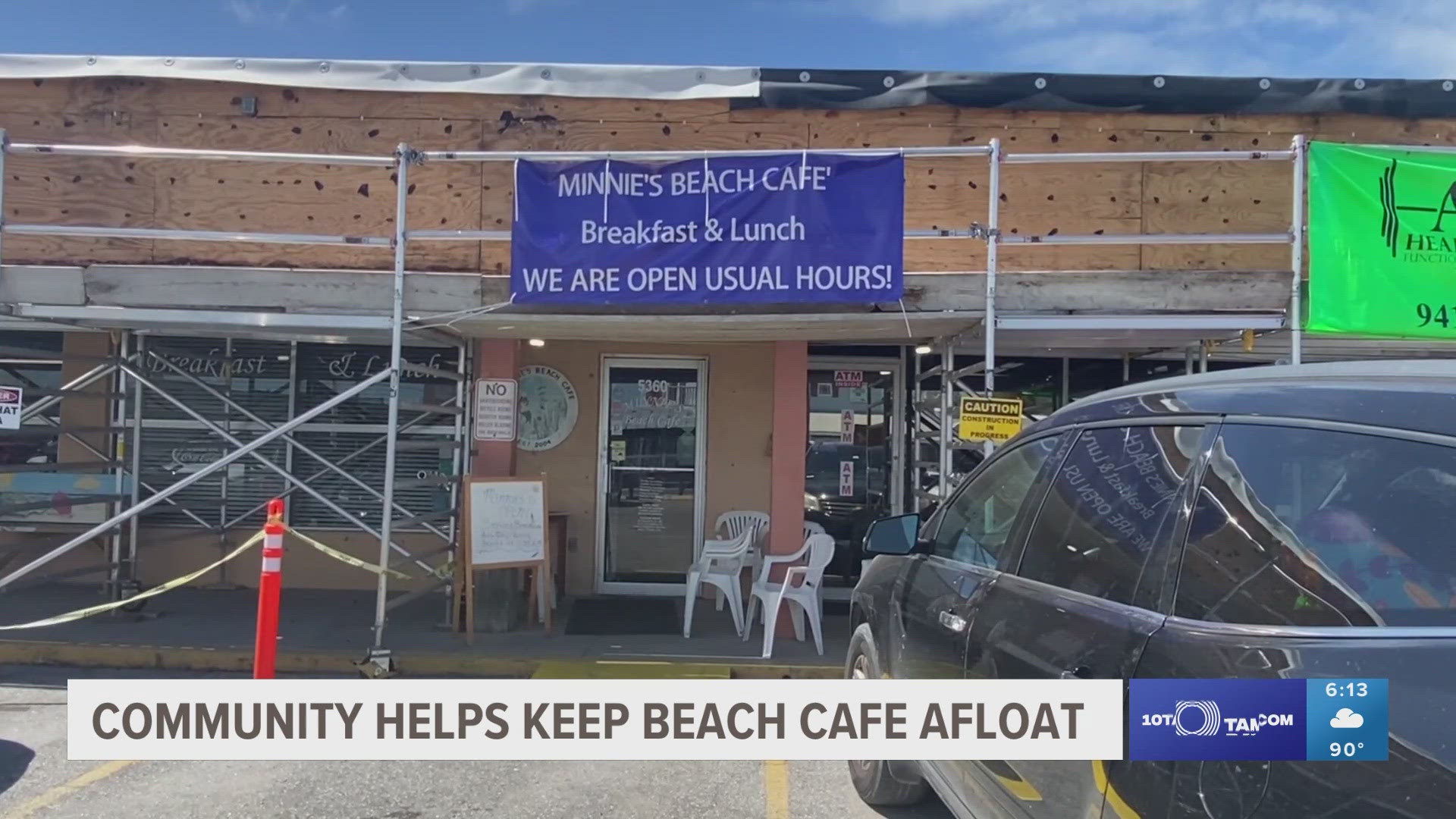Blue Origin’s suborbital New Shepard rocket booster earned its place in history as the first rocket booster to launch into space and then land back on land, ready to be reused.
On Tuesday morning, the company aims to launch the booster for a fifth and likely final time from a private range in West Texas.
“We’d really like to retire it after this test and put it in a museum,” said Blue Origin founder Jeff Bezos. “Sadly, that’s not likely.”
The unmanned test flight will jettison New Shepard’s crew capsule from the rocket about 45 seconds after liftoff, at an altitude of 16,000 feet.
The in-flight abort will test the system’s ability to save a crew from a failure at the most stressful moment, when the vehicle is under peak aerodynamic pressure. If all goes well, the capsule will push itself away from the rocket and parachute to the ground.
But the 2-second firing of the capsule’s solid rocket escape motor is expected to send the booster careening out of control to a fiery crash. Most of its fuel will still be on board.
There’s a small chance the booster could right itself and land intact. A retirement party and museum placement would follow, Bezos said.
More likely, he said, “its impact with the desert floor will be most impressive.”
Blue Origin plans to Webcast the test flight, starting at 10:50 a.m. EDT Tuesday.
The company hopes to fly space tourists on suborbital flights as soon as 2018. It is also developing orbital New Glenn rockets that will be built and launched from the Space Coast, possibly before the end of the decade.
Vandenberg fires under control
In California, United Launch Alliance is standing by for a new date to launch an Atlas V rocket and commercial Earth-imaging satellite once the Western Range resumes normal operations.
Wildfires burned more than 12,000 acres over the past two weeks at Vandenberg Air Force Base, postponing planned attempts to launch DigitalGlobe’s WorldView-4 satellite on Sept. 18 and Sept. 26.
No launch infrastructure was damaged, and the rocket and spacecraft remained safe throughout.
But the base continues its recovery from the fires, whose cause is under investigation.
The last official update, posted Sept. 25, said burned areas remained dangerous, with smoldering hot spots and the potential for trees on unstable ground to fall without warning.
ULA simultaneously is preparing for a Nov. 4 launch of an Atlas V from Cape Canaveral Air Force Station with a next-generation national weather satellite.
ISS crew hopes to launch this month
Launch of a three-person crew including NASA’s Shane Kimbrough to the International Space Station is now targeted for Oct. 19, according to Russian news reports.
A planned Sept. 23 liftoff from the Baikonur Cosmodrome in Kazakhstan was delayed after tests determined an electrical short had damaged a cable that needed to be replaced.
The flight will be the second of an upgraded version of the Soyuz, called MS.
Kimbrough, a retired Army colonel, is making his first long-duration flight following a 2008 mission to the station aboard the shuttle Endeavour.
Russian officials are scheduled to meet next week to review the launch’s status.
New Antares nears flight from Virginia
As soon as next Sunday, Oct. 9, Orbital ATK hopes to launch an Antares rocket from Virginia for the first time in two years, sending cargo to the International Space Station.
Antares’ return to flight from the Mid-Atlantic Regional Spaceport is targeted during a five-day window running through Oct. 13. A launch on Oct. 9 would be at 10:47 p.m.
The Antares has a new main propulsion system, powered by Russian RD-181 engines.
They replaced Soviet-era engines that had been refurbished, but failed seconds after liftoff on Oct. 28, 2014, causing the rocket to fall back to the ground with a spectacular explosion.
A successful Antares launch of a Cygnus cargo vehicle is important while SpaceX’s Falcon 9 rocket is grounded after a launch pad explosion on Sept. 1.
SpaceX says it could be ready to launch a cargo mission in November, but a failure investigation is not complete and its unknown how quickly a Florida launch pad will be ready.
NASA needs at least one of the two companies flying missions to ensure that space station crews have enough food and equipment.
Pioneers celebrate golden anniversary
The public is invited to join a celebration of the Missile, Space and Range Pioneers' 50th anniversary on Oct. 21 at the Courtyard by Marriott in Cocoa Beach.
Kennedy Space Center Director Bob Cabana and Apollo 13 Lunar Module Pilot Fred Haise will headline an astronaut panel speaking at the evening banquet themed, “Space Pioneers: Past, Present, and Future.”
The event begins at 5:30 p.m. with dinner served at 7 p.m. Tickets are $45 for members, $60 for non-members and $35 for students and active military. Visit www.missileers.org for more information.
Incorporated on Nov. 2, 1966, the Missile, Space and Range Pioneers creates opportunities for people involved in the early missile, space and range activities at Cape Canaveral to socialize and share their experience and vision with the next generation.
Vulcan begins path to certification
United Launch Alliance and the Air Force have signed an agreement outlining how the company’s Vulcan rocket can earn certification to launch national security space missions.
Vulcan is the lower-cost, partially reusable rocket that ULA, a Boeing-Lockheed Martin joint venture, is developing to replace its current fleet of Atlas V and Delta IV rockets to stay competitive with SpaceX.
The Vulcan could be ready for a first flight by late 2019. ULA plans to pick the rocket’s main engines next year, with Blue Origin’s BE-4 engine considered the favorite over Aerojet Rocketdyne’s AR-1.
The agreement with the Air Force’s Space and Missile Systems Center anticipates Vulcan flying at least twice before earning certification.
SBIRS launch moving to 2017
Launch of a missile warning satellite from Cape Canaveral that had been planned this week is not expected before January, the Air Force says.

The Air Force last month postponed the launch, which had been scheduled for Oct. 3, of SBIRS GEO-3, the third Space Based Infrared System satellite bound for a geosynchronous orbit more than 22,000 miles up.
Engineers wanted time to make sure review the Lockheed Martin satellite’s main engine system, after two other satellites experienced problems. One of them, the Navy’s MUOS-5 communications satellite, also built by Lockheed, has been struggling to reach its high operational orbit several months after launching.
The review is expected to be completed soon, but the mission will likely have to wait until at least January to fit into United Launch Alliance’s Atlas V launch schedule.
“Ensuring the safety of our national security space assets is critical and we will extensively investigate all possible causes before launching the SBIRS GEO-3 satellite,” said Lt. Gen. Samuel Greaves, commander of the Air Force’s Space and Missile Systems Center in Los Angeles.
Contact Dean at 321-242-3668 orjdean@floridatoday.com. And follow on Twitter at@flatoday_jdeanand on Facebook atfacebook.com/jamesdeanspace.


